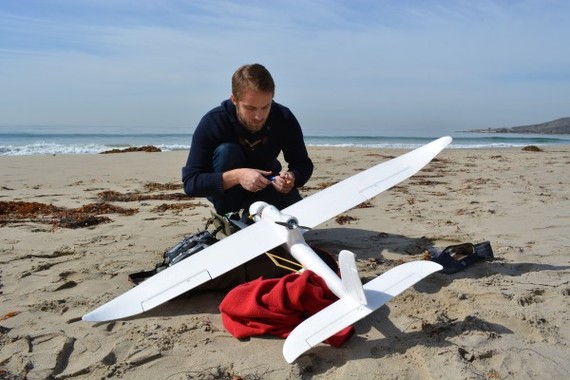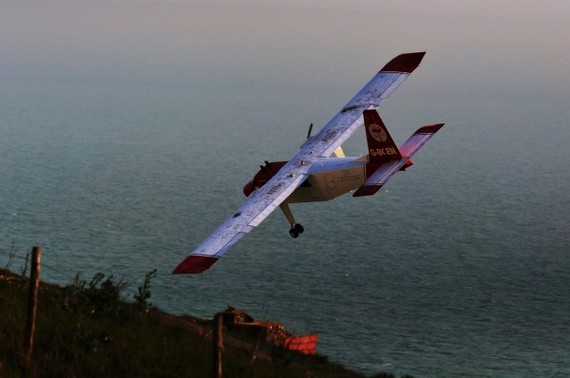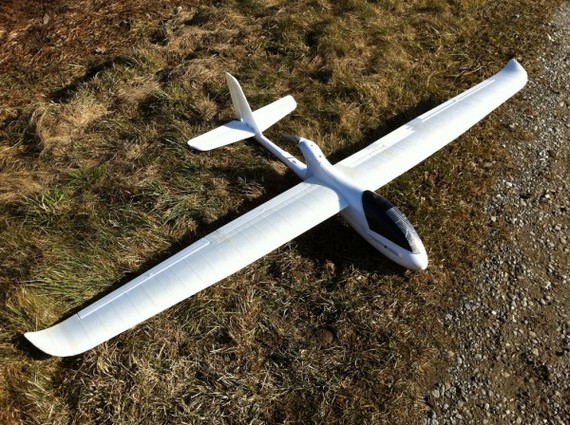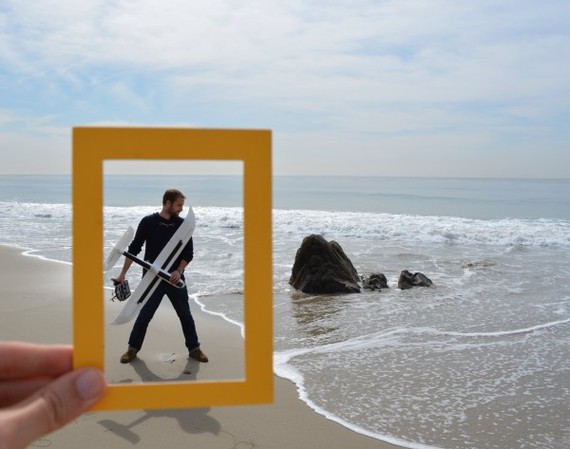National Geographic Emerging Explorer Shah Selbe setting up his ArduPlane drone for some coastal flight tests. Photograph © Omeed Selbe
A robust and healthy ocean is the lifeblood for our planet, sustaining life through interconnected ecosystems worldwide. Unfortunately, as a result of global industrial overfishing pressure, many of these ecosystems have shown signs of rapid deterioration. This is particularly bad in the high seas, the part of the oceans that lie beyond 200-miles off the coast, where we are facing a tragedy of the commons. Nearly two-thirds of the fish stocks in those areas are over-exploited, with the situation in many coastal areas much worse.
Fortunately, there is a solution that has shown promise. Through establishing marine protected areas, we can create sanctuaries that protect the ecosystem from destructive fishing practices. Much like the national parks we see on terrestrial land, these can provide legal protection that will allow the fish stocks to rebound. Explorer-in-Residence Enric Sala has demonstrated through the Pristine Seas Expedition the importance of setting up these marine reserves to help protect these habitats, safeguard biodiversity, and restore fisheries. Currently less than one percent of the high seas have any sort of protection, but there are efforts underway to increase this substantially.
However, just establishing these marine reserves on a map or in our laws and treaties is not enough. The benefits of these areas can only be realized through effective monitoring and enforcement. Without the ability to ensure that these regions are protected, they risk falling to the same fate as the unprotected areas that surround them. This recent expansion of the creation of these reserves has started to expose the limitations in our traditional approaches to protection. So, in order to supplement our monitoring capacity, we need to look to the incorporation of new technologies. This area where new technologies meet these ocean conservation challenges is the focus of my work (and a series of future blog posts on Ocean Views).
A Coast Guard Plane flies over the coast for monitoring efforts. Photograph © Flickr user mistyanddavid
Traditionally, one of the most important tools in monitoring and protection of the oceans is aerial surveillance. When used for our ocean, current approaches involve rental of flight time on private aircraft or the use of military aircraft as a secondary mission. Unfortunately, this method typically results in less desirable coverage or lower frequency of flights due to the high costs involved and pilot limitations. Large governments or resource-rich organizations typically operate these flights in order to absorb the capital costs of the equipment, fueling, and flight operations. But for coastal areas outside of wealthy countries, this approach just seems too out of reach to regularly help them watch over their seas.
Thankfully, there now exists a technology that can change this approach forever. The Unmanned Aerial Vehicle (commonly called a UAV, UAS, or drone) is a reusable robotic aircraft that can fly without a human pilot or crew on-board and, as a result, does not suffer the same issues associated with pilot fatigue or high operational costs. In recent years, this technology has been all over the news. Unfortunately, much of that public consciousness has been wrought with criticism as a result of its military uses.
Much of that controversy fails to realize that drones are a general-purpose technology, much like the computer, and can be used for both good and bad uses. Through the military uses and a large hobbyist following (websites like DIY Drones and the Drone User Group Network), the technology has benefited from an impressive rate of innovation and development (both commercially and open source). These systems have been growing at such a pace that the hobby market and toy industry are building UAVs that rival the options provided by the military-industrial complex. The miniaturization of cameras, sensors, batteries, and other hardware as a result of the popularity of smartphones has further increased these capabilities.
So now there exists a great opportunity for environmental and humanitarian causes to take full advantage of the technology growth seen here. Through the democratization and demilitarization of drone technology, there are a number of issues that can be solved more cheaply and effectively than our current methods. As Patrick Egan of sUAS News says, "There's a lot of good that can be done with this technology. Feeding a hungry world, private-public asset management, erosion studies, anti-poaching efforts, anti-deforestation... the list goes on and on."
There have been demonstrations of drone usefulness in things from scientific missions, to orangutan protection, to search and rescue, to firefighting, to rhino poaching surveillance, and much more. There also exists a Wildlife Conservation UAV Challenge, where over 120 teams have competed to design, build, and fly drones to help stop rhino poaching. They have even began to be used to create art. So there is plenty of opportunity here beyond just aerial photography and military uses that we all have heard so much about.
Conservation drone 2.0 built by Lian Pin Koh and ConservationDrones.org for the orangutan study.
I believe that there is one area where drones will really soar: for use in ocean conservation. As I mentioned above, plane-based aerial monitoring of our oceans is already a practice that is prevalent globally. Manned flights at sea can be dangerous, where low cost UAVs would easily fill that use without the risk to human life. Through controlling the drone with a ground station far away, the same concerns with pilot fatigue and flight time disappear (with the only practical limitation being the amount of battery power or fuel on board).
Having these robots in the sky can also act as a deterrence, as Thomas Snitch, executive officer of the UN Wildlife Enforcement Monitoring System, said of his experience in Balule, "the poachers are terrified to go into Balule because the word on the street is that there are machines in the sky that can see at night, and the rangers know where they will walk." This type of deterrence is just what we need for our ocean, which currently resembles the "Wild West" in some areas. Through documenting what is happening out there, evidence can be collected for use in legal prosecution and provide a more effective patrol for the enforcement vessels already out on the water.
There have been some great examples of the usefulness of this approach. NOAA (National Oceanic and Atmospheric Administration) has a UAS program that has been flying capability demonstrations since 2005, which includes a program to do marine monitoring. Recently, Aerosonde Ltd. flew a series of successful tests for the President of Palau to demonstrate the technology in looking for illegal fishing. This is particularly important with the recent proclamation by President Tommy Remengesau Jr. to the United Nations to make Palau's waters a marine sanctuary, closed to all fishing.
Even back in 2011, the anti-whaling activist organization Sea Shepherd made use of drones in efforts against Japanese whaling vessels. A recent video from a whale-watching company in California also went viral because of the incredible footage that they were able to capture with a commercial drone:
These are just a few examples, but there are many more efforts that are under work for 2014 and the years to come. One of those efforts is SoarOcean, a National Geographic and Lindblad Expeditions Fund for the Oceans grant-funded project to demonstrate the use of inexpensive conservation drones for ocean protection and MPA monitoring. The goal is to show the benefits behind using low-cost open source technology and hobby RC aircraft to get some of the same capabilities demonstrated in the examples outlined above.
Over the next few months, there will be testing conducted in marine reserves in the Pacific Ocean and documentation of strategies that would be most useful in the field by coastal communities, conservationists, and fisheries monitoring officials. The results will be posted here on Ocean Views, on the SoarOcean website, and on Twitter at @SoarOcean.
National Geographic Emerging Explorer Shah Selbe with his National Geographic and Lindblad Expeditions funded SoarOcean project. Photograph © Omeed Selbe
Drone technology is in the midst of a technological boom. In the coming years, we will be seeing more and more uses for these platforms and acceptance into the industries that are ripe for this sort of innovation. The U.S. Federal Aviation Administration and the National Transportation Safety Board are working to define a framework for bringing drones into the national airspace. The original deadline was to incorporate commercial use of UAVs by 2015, a deadline some are skeptical will be reached.
So if you're ever at the beach and see one of these robotic planes flying overhead, it just might be working towards a better future for our oceans.



